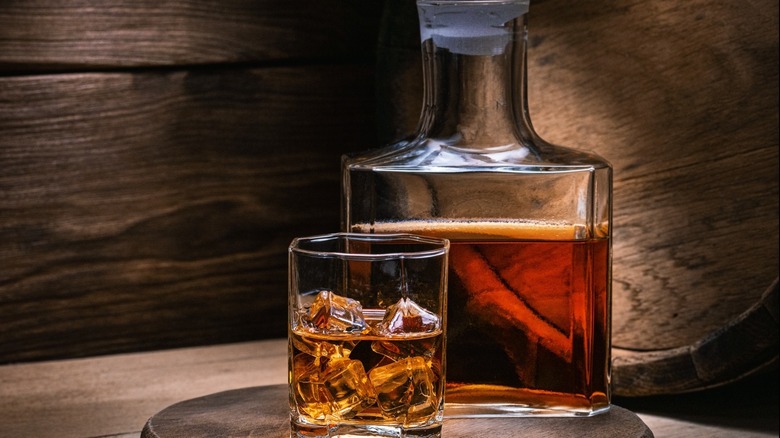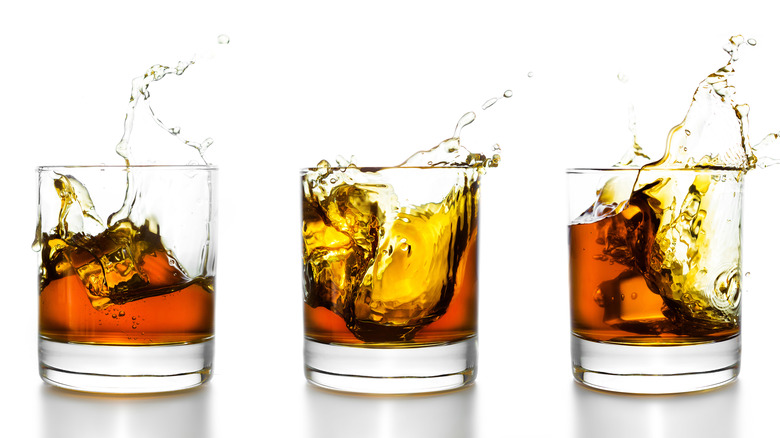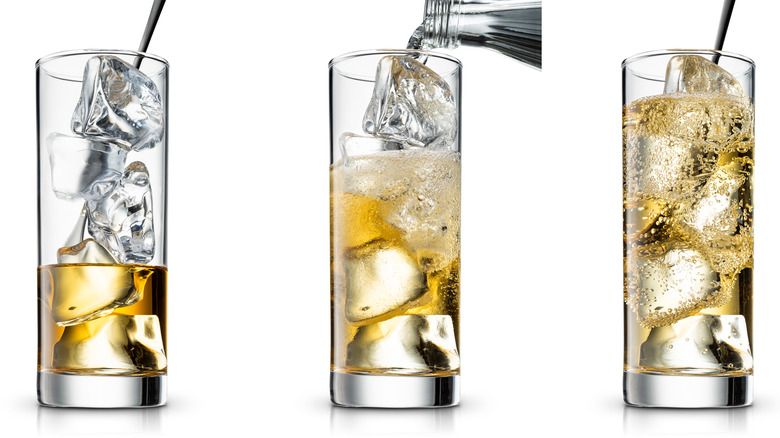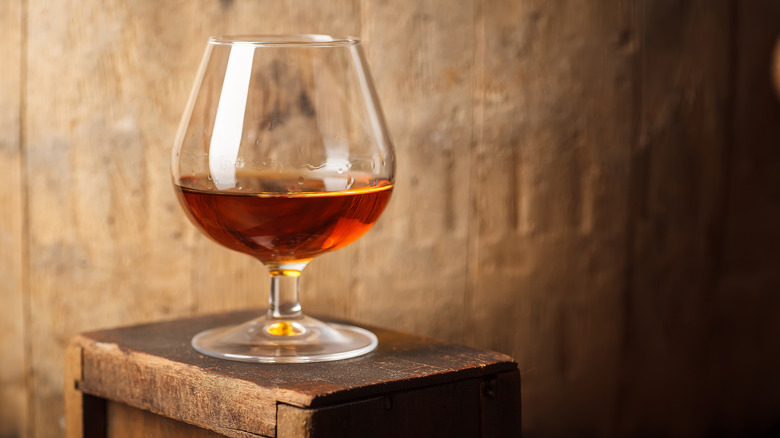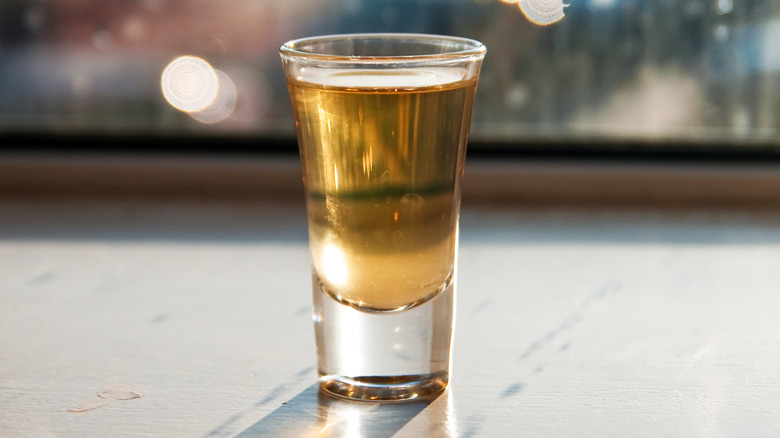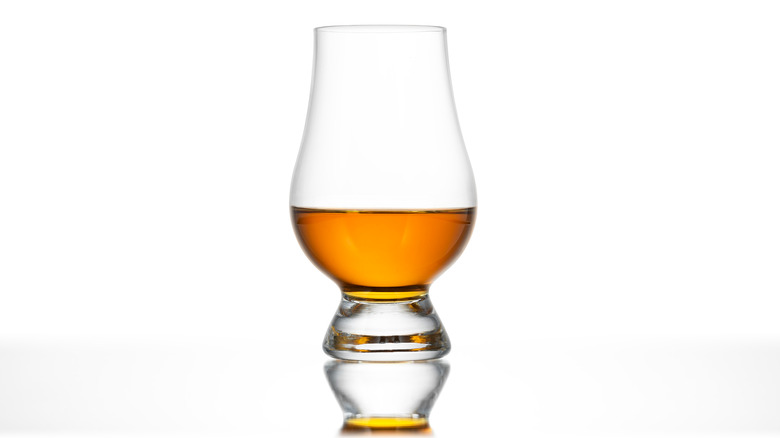5 Types Of Whiskey Glasses And How To Use Them
If you are a connoisseur, you collect a lot of stuff. Think about it; the more you know about wine, beer, and whiskey, the more things you "need" to enjoy them. A wine connoisseur may have 18 varieties of wine glasses to showcase their red, white, and dessert wines. A beer connoisseur could have 24 glasses, from a Weizenbier to a tankard. So whiskey connoisseurs have it easy, with just a handful of glasses to add to their collection.
It may not seem like a lot, but different glasses do affect the tasting experience (via Taster's Club). As the popularity of whiskey continues to grow (per Forbes), connoisseurs and restaurants will likely be keen to collect the proper barware to elevate the experience. With a fancy glass in hand drinkers can feel sophisticated before taking their first sip. Crystal glasses can be made paper-thin compared to regular glass, making the transition smooth and enjoyable from the glass to the lips (via The Standard Drink). Crystal also refracts light like a prism, making it special to hold and look at.
Eating and drinking are multi-sensory, so the aroma of the whiskey is vital to the overall experience. The stem and rim of a glass can affect the temperature and direction of the nose, impacting the drink's overall taste (via Christner's). If you are a whiskey connoisseur, read on to learn about the five popular styles of whiskey glasses, all of which serve a purpose.
Lowball glasses
The most common glass for drinking whiskey is the lowball, also called rocks glass, whiskey tumbler, and old-fashioned. These glasses range from 6- to 14-ounce capacities, and with a wide rim and straight sides, can accommodate ice cubes, whiskey stones, or additional ingredients to mix, making the glass versatile (via Serious Eats).
Rocks glasses come in various shapes and materials, allowing for a comprehensive price point to suit every budget. Cut crystal glasses showcase their sophistication and cost, regardless of what's inside the glass. If you'd like the whiskey to be the focal point, opt for a sleek design of blown crystal. Expensive glasses should feel heavy, mainly in the base, to keep the glass from tipping over and feel good in your hand, BlackTailNYC suggests.
The Home Wet Bar blog features more gimmicky glasses like a cigar holding glass; after all, whiskey and cigars are a match made in heaven for some. Monogrammed everything seems to be having a moment, so glasses seem like a logical item if your guests have sticky fingers. There are retro looking square-shaped glasses and ones with a real bullet piercing the sides, which may have been ideal for binge-watching "Peaky Blinders".
Although whiskey can be served neat (no ice) in a lowball, the wide rim isn't ideal for nosing (per WhiskySuggest). Instead, this glass is best suited for classic cocktails like an old-fashioned or whiskey sour. Another benefit is that the lowball fits in the dishwasher.
Highball glasses
The taller sibling of the lowball is, of course, the highball. The design, also referred to as the Delmonico, the Collins, and a chimney-style glass, ranges from 5- to 16-ounces in capacity (via Serious Eats). The John Collins, made with whiskey, is much like another Collins, the Tom Collins, named after a prank circulating the taverns of New York City and was referred to in the papers as The Great Tom Collins Hoax of 1874 (via VinePair). Although the Delmonico and Collins are slightly different in size and are used interchangeably now, some bartender purists will only serve a Tom Collins in a Collins glass, Serious Eats notes.
The base of the highball should be heavy, similar to the lowball, to prevent the glass from tipping over and breaking. Due to its size, the highball is ideal for cocktails with a higher percentage of non-alcoholic mixers and ice, including the famous whiskey highball or the very sippable and sweet 7 & 7. Unless you prefer to wash your glasses by hand, make sure the highball is a reasonable size, since some of them can be too large for a dishwasher.
The snifter
The snifter, also known as a balloon, or a brandy or cognac glass, is the high-brow cousin of the highball and lowball. This glass gives an air of sophistication well suited for sitting in a leather club chair by the fire in a gentleman's club. The snifter is also used for brandy and its French offspring, cognac, both made from grapes.
The snifter was precisely engineered to enhance the sensory experience while sipping from it. Its balloon shape allows for swirling the liquid, aerating it without spilling, as BlackTailNYC notes. Opening up the whiskey amplifies the aromas trapped in the bulbous body due to the narrow rim. When the drinker lifts the snifter to their mouth, the bouquet is released to provide an olfactory experience to compliment the taste. The short stem of the snifter is intentional, so the drinker palms the glass in their hand, allowing their body temperature to warm the alcohol, further releasing the nose.
According to one critic, Living By The Dram, the tight rim can promote the release of ethanol vapors when the whiskey is aerated in the snifter's wide body. These ethanol vapors can numb the olfactory sensors and prevent the drinker from experiencing the nose of the whiskey.
Shot glasses
Just as a snifter belongs in a gentlemen's club, a shot glass belongs in a seedy, sticky-floor bar. Expensive crystal shot glasses make the rare occasion you need a shot of whiskey fancier, but the souvenir shot glass you bought at the airport will work just fine. Two types of shot glasses can be used to drink whiskey: the shooter and cordial.
A shooter is a tall version of a shot glass that allows for a double shot, layering of spirits, or a shot of a mixed drink (via Totally Inspired). The shooter is reminiscent of a test tube. The nose of the whiskey goes straight up, so there isn't much of a bouquet, but you likely aren't drinking from a shot glass to experience the aroma. Shooters range from 2 to 3 ounces in capacity.
The cordial or tulip-shaped glass is fancier than the shooter. This glass often has a stem, and the shape is meant for sipping instead of shooting, and so can also be found in larger capacities. According to Bogue Sound Distillery, the cordial glass can be referred to as a copita, after the Spanish sherry glass it was modeled after. Once favored by merchants, the glass was also called the "dock glass" as it was often seen dockside filled with wine or whiskey. Today the glass is favored by distillers, blenders, and connoisseurs alike. Cordial glasses range from 1.5 to 2 ounces in capacity (via Vinepair).
Glencairn whiskey glasses
The final glass, a proprietary design, is relatively new to the market and solely used to drink whiskey, The Whiskey Reviewer notes. The Glencairn has been endorsed by the Scotch Whisky Association (via WhiskeyMasters), and used by all Scottish and Irish distilleries after being awarded the Queen's Award for Enterprise, according to the BBC. Glencairn glasses hold about 6.5 ounces and are favored by those that don't like a stem and prefer a less fussy version of a tulip-shaped glass. The Glencairn is sturdy with its broad base and small enough to fit in a dishwasher.
Similar to the snifter, the Glencairn glass is meant to be swirled to open up the whiskey, providing drinkers with a sensory experience amplified by the warmth of your hand (via Glencairn Crystal). The tulip shape concentrates the bouquet while the narrow brim directs the aromas to your nose as you sip the brown spirit. The glass is meant for top-shelf whiskey served neat or with a little water.
Each whiskey glass style has specific characteristics to enhance the subtle nuances of the different types of whiskey. From the quality to the glass weight, these details affect the experience of drinking whiskey. If you don't believe us, compare drinking from a red plastic cup to a crystal lowball and decide for yourself. Like magic, the flavor of the whiskey will change, and the experience will be holistic. If you are in the market for whiskey glasses, consider the glass material, cost, purpose, and maintenance to purchase the best whiskey glass for you and your needs.
